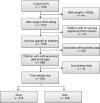Risk factors during the prenatal period and the first year of life associated with overweight in 7-year-old low-income Chilean children
- PMID: 23241511
- PMCID: PMC6860292
- DOI: 10.1111/mcn.12024
Risk factors during the prenatal period and the first year of life associated with overweight in 7-year-old low-income Chilean children
Abstract
The objective of this study was to identify in low-income Chilean children with normal birthweight which factors occurring during the prenatal period and the first year are associated with overweight (OW)/obesity at 7 years. The sample included 652 7-year-olds from a larger cohort study. We collected anthropometric data at 0, 12 and 84 months, maternal pre-pregnancy and pregnancy characteristics, early feeding practices, number of siblings, birth order, breastfeeding, and timing of solid introduction information. We determined the residuals for z-scores for body mass index (BMI) (BAZ), weight/age and height/age0-12 months , run univariate analysis (X(2) or t-test) and multivariate logistic analyses (stepwise approach); P < 0.05 was considered significant. We evaluated the goodness of fit of the model using the Hosmer-Lemeshow test and checked for overdispersion using the Pearson's X(2) . The odds of children being OW at 7 years increased if their mothers were OW before pregnancy, if born with a higher BAZ (increase of 18-74% per each additional unit of BAZ) and if their BAZ growth during the first year was higher (62-239% per each unit over the predicted BAZ increase). Higher birth order was protective (6-68% less risk for 2nd birth compared with 1st and 10-73% less for ≥3rd child). All other variables, including gender, were non-significant (P > 0.1). In low-income Chilean children with normal birth, four factors during the prenatal period and the first year were associated with OW at 7 years: pre-pregnancy BMI, BMI at birth, BMI gain between 0 and 12 months, and birth order.
Keywords: birth order; birthweight; childhood obesity; prenatal; weight gain.
© 2012 John Wiley & Sons Ltd.
Conflict of interest statement
The authors declare that they have no conflicts of interest.
References
-
- Al‐Isa A. & Moussa M. (1999) Factors associated with overweight and obesity among Kuwaiti kindergarten children 3–5 years. Nutrition and Health 13, 125–139. - PubMed
-
- Armstrong J. & Reilly J.J. (2002) Breastfeeding and lowering the risk of childhood obesity. Lancet 359, 2003–2004. - PubMed
-
- Bogen D.L., Hanusa B.H. & Whitaker R.C. (2004) The effect of breast‐feeding with and without formula use on the risk of obesity at 4 years of age. Obesity Research 12, 1527–1535. - PubMed
Publication types
MeSH terms
LinkOut - more resources
Full Text Sources


